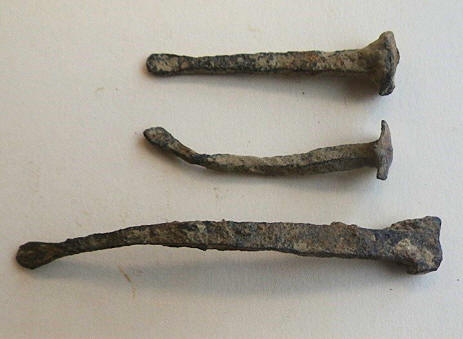While one would assume that hand wrought nails made
by blacksmiths were pretty much alike, one would be
wrong.
As it turns out, the early colonial period saw two
types of nails being fabricated, the type one
usually associates with blacksmithing (that today
are described by the term "rose head" nails), and
then the other type, substantially more malleable
and specifically fabricated for coffins.
Dupui's general store sold both types of nails, with
customer Peter Pugh purchasing "Boards for a coffin
and nails", with a later separate entry that month
for a "pound of nails" (which cost him a shilling
and two pence). Apparently, these more
malleable coffin nails were utilized often enough to
warrant remaining in Dupui's long-term inventory.
Ledger entries included the following:
-
"By making a Coffin for
the Negro Wench"
-
"By making a Coffin for
Aaron"
-
"By making a Coffin for
my Son"
Initially, and unlike the English tradition that saw
nails sold by the hundred, nails were sold at
Dupui's store by the pound. For example, we
note a 1745 purchase by Benjamin Schoonmaker for "36
pounds of Nails" at a cost of 2£ and 2 shillings.
Some forty years later, a ledger entry for Patrick
White would, by contrast, read: "By Cash to
205 nails." A different unit of sale had
emerged.
A point of interest: while we are most
familiar with a pointed tip, spatulated
tips, which were usually struck with a
hammer once to flatten the metal at the tip,
were less likely to split the wood they were
being driven through.
From their earliest use through the 18th
century, all nails were hand-wrought.
Blacksmiths created wrought nails
individually from a square iron stock rod.
To make a nail, the blacksmith would heat
the rod until it was red hot and malleable,
then the process of shaping the nail could
begin.
|
|
 |
The blacksmith hammered the heated rod on all four
sides to make a point, and then cut it to the
desired length. The head of the nail could be formed
into any of a variety of different shapes depending
on the nail’s intended use and the time period in
which it was produced. The resulting product tapered
on all four sides, one of the defining
characteristics of a wrought nail.